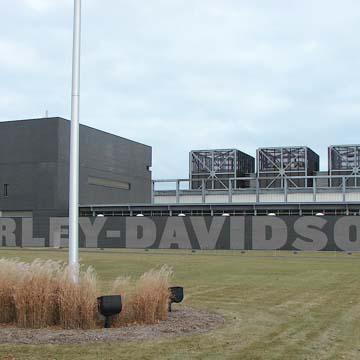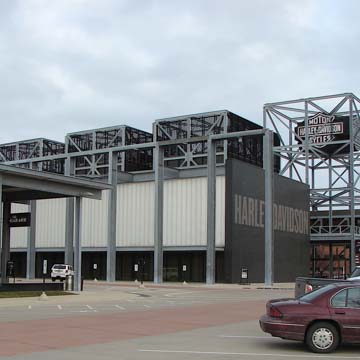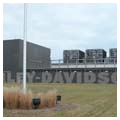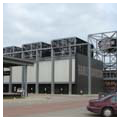James Biber, then with Pentagram Architects, designed the Harley-Davidson Museum complex to suggest a factory town. Sited on a twenty-acre reclaimed brownfield on a peninsula bounded by the Menomonee River, the complex consists of three buildings, linked by steel and glass bridges, at the intersection of Canal and 5th streets. M. A. Mortenson Construction was the contractor for the museum. Landscape architects Oslund and Associates designed this crossroads to accommodate rows of motorcycles along the broad orange stripe that runs down the center of these streets to evoke the Sturgis, South Dakota, motorcycle rally that draws hundreds of thousands of “hogs” each year.
The Annex Building, which houses temporary exhibitions and an archive, features large garage doors of glass and steel, and corrugated metal walls, giving the one-story exhibition space an industrial look. Behind this block rises a three-story cube of glazed black brick, its upper stories slightly broader than its base. Only two small horizontal slits of windows break the solid, opaque walls, the better to protect the historical artifacts and archival materials inside. Next door is the main attraction, the museum, a long rectangular box of glazed black brick at ground level and corrugated metal panels above. It is flanked on the west elevation by a steel colonnade and on the east by four towers inspired, according to Biber, by the rhythmic images of aging industrial structures taken by German photographers Bernd and Hilla Becher. From the corner tower, sheltering the entrance, hangs a four-sided Harley-Davidson logo. Across Canal Street is the bronze Hill Climber by Jeff Decker. The two-story museum shop and restaurant echoes the design of the temporary exhibit space. Here, however, the top rectangle appears to have slipped off center, so that it cantilevers over the east wall, providing morning shade and a vista of the river beyond. The black, orange, white, and silver palette found throughout the complex expresses the iconic colors of Harley-Davidson.





